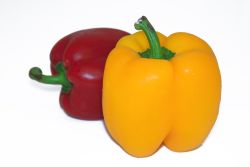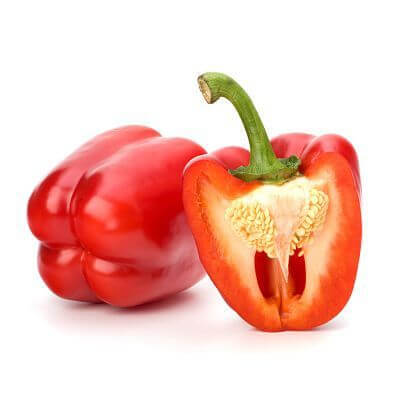Preparing Bell Peppers For Baby
Updated Sept 28th, 2023
Some parents are unsure about preparing bell peppers for baby.
Yet these colourful, delicious and nutritious vegetables are an ideal addition to your baby’s diet – and we’ll show you how to prepare them in ways he’ll enjoy!

PLEASE NOTE: The information provided here is meant as a guide and does not replace professional medical advice.
Please speak to your child’s doctor before introducing ANY new foods and be sure to apply the four day rule as you include each new food in your baby’s diet.
Preparing bell peppers for baby – more about this amazing vegetable
Bell peppers are known in different parts of the world by a variety of names.
They are sometimes called sweet peppers, capsicums, pimentos or – in some midwestern parts of the United States – mangos!
The word “pepper” instantly makes you think “hot” – but bell peppers are the ONLY type of peppers that don’t contain capsaicin (the substance that makes all the others hot).
Bell peppers come in a variety of colours, including green, red, purple, yellow and orange!
This, of course, makes them a very visually appealing vegetable to babies!
The colour of a bell pepper depends on the stage of ripeness and the variety of the plant.
Did you know, for example, that a green bell pepper is just an immature red pepper?
The flavour of a bell pepper changes as it ages, becoming more subtle and sweet.
This is why red peppers are sweeter and less bitter than green ones!
Nutritional information
Bell peppers contain folate and are a good source of vitamin A (from beta-carotene), vitamin B6 and vitamin C.
In adulthood, it is believed that bell peppers protect the body against rheumatoid arthiritis and may also prevent the development of cataracts.
Red peppers have the edge on green ones in terms of nutritional value, as they contain more folate, an impressive nine times more beta-carotene and lots of lycopene.
Lycopene is an important carotenoid and plays a valuable role in later life, by protecting against cancer and heart disease.
Bearing in mind this array of health benefits, it’s a good idea to establish a love and appreciation of bell peppers from an early stage!
Buying and storing these colourful vegetables
The Environmental Working Group regularly publishes a list of the “Dirty Dozen” foods high in pesticide residues.
Bell peppers appear frequently on that list.
The FDA recommends washing or peeling vegetables in order to remove pesticide residues.
But because bell peppers are so commonly found to harbour them, many people prefer to stick to the organically grown varieties.
Read more about the pros and cons of peeling fruits and veggies for your baby
When you are choosing bell peppers to cook for your baby, look for ones with bright, deep colours and fresh, green stems.
Avoid those with wrinkled or blemished skin.
Don’t worry about the shape, though – it doesn’t affect the quality or taste in any way!
Preparing bell peppers for baby
To prepare a bell pepper, wash it well then remove the stem by cutting around it with a paring knife.
Next, halve it lengthwise and remove the core and the seeds.
You can then cut it into chunks, strips or dice, according to your recipe.
Alternatively, you can cut bell peppers into rings by slicing them horizontally – or simply clean out the seeds and leave the rest of the pepper intact for stuffing.
Baby food ideas
As mentioned earlier, red bell peppers are sweeter – and more nutritious – than green, making them an ideal choice for baby.
Yellow and orange peppers also have a nice, sweet flavour.
You can begin including cooked bell peppers in your baby’s diet from 6 months of age (with your doctor’s consent).
Remember to watch carefully for any signs of allergic reaction or digestive problem.
In our opinion, there is nothing to compare with the delicious flavour of a roasted red pepper – and it’s so simple to prepare!
To roast a bell pepper...
Either
- Hold a red bell pepper, using tongs, directly in the flame of a gas burner and keep turning it until its blackened on all sides.
- Place a whole red pepper in your grill (broiler) and, as above, turn until the skin is blackened.
- Throw a red pepper on to the barbecue and turn until charred.
The next step is to remove the skin…
This is very easy to do – just pop the cooked pepper into a sandwich bag and leave it to sit for 10 minutes.
When you come back, the skin will slip right off.
You can then split the pepper and easily remove the seeds, then put it into a blender and puree it.
You can use your red pepper puree in a variety of ways…
- Serve it as a nutritious and tasty dip for finger foods.
- Combine it with cream cheese and spread it on wholemeal bread as a tasty sandwich filling.
- Combine it in a food processor with cooked zucchini (courgette) and sauted onions to make a soup that tastes great either warm or cold.
More ideas
- For older babies who are chewing well, slice a sweet red pepper and serve it as a finger food, accompanied by a cream cheese dip (learn more about serving uncooked fruits and vegetables to baby)
- Cook a stuffed bell pepper!
Plunge a de-seeded whole pepper into boiling water for a few minutes, then transfer to a container of iced water to stop the cooking process. Drain.
Then stuff the pepper and bake it for around half an hour at 350 deg F.
You can use anything your baby enjoys to stuff the pepper, but ideas include cooked brown rice, a little sauted garlic and onion, chopped tomatoes and mushrooms and a little touch of oregano. - Stir chopped peppers into soups, casseroles or stews for your baby.
Bell peppers recipes for baby
Baby’s Chicken and Red Pepper Dinner (7 months+)
1 chicken breast (boneless and skinless), chopped
1 small red pepper
1 tsp fresh dill (optional)
2 oz (1/4 cup) butternut squash, diced
2 fl oz (1/4 cup) homemade chicken stock
- Place the chicken breast and butternut squash into a saucepan and pour in the stock.
- Bring to the boil, then reduce the heat and simmer for 20-30 mins, until the chicken is cooked through and the squash is tender.
- Meanwhile, roast the red pepper using the method described above, then peel. Puree the red pepper in a food processor.
- Finally stir the red pepper puree into the chicken mixture (along with dill, if using) and either puree, or chop to the right size for your baby.
Eggplant (Aubergine) and Red Pepper Curry (6 months+)
NOTE: Some parents prefer to wait a little longer before introducing eggplant – please see this page for more information
1/2 small eggplant (aubergine), cubed
1/2 small onion, chopped
2 tsp olive oil
pinch ground ginger
pinch cumin
pinch ground coriander
pinch cinnamon
pinch turmeric
1 fl oz (1/8 cup) unsweetened apple juice
2 fl oz (1/4 cup) water
1 small red bell pepper, cubed
- Heat the oil and saute the onion for a few minutes, then add all the spices and continue to saute, stirring continuously, for 2 more minutes.
- Add the eggplant, apple juice and water and cover. Reduce the heat and simmer gently for 10 mins. Add the bell pepper and cook for another 5-10 minutes, until the red pepper is tender.
- Chop all ingredients to the desired size and serve with brown rice.
Red Pepper and Pasta Dream (6 months+)
2 oz uncooked pasta (something like rigatoni is ideal, because the tubes tend to hold the sauce – perfect if your baby likes to eat pasta with his fingers!)
8 oz (1 cup) red bell pepper, chopped
1/2 garlic clove, crushed
3 fl oz (1/3 cup) homemade chicken stock
1 tsp tomato puree (paste)
1 tsp fresh basil, chopped
- Simply place all ingredients (except the pasta) in a saucepan and bring to the boil.
- Reduce the heat and simmer for around 20 mins, until the mixture begins to thicken a little.
- Meanwhile, cook the pasta according to the directions on the package.
- Finally, puree the red pepper mixture and pour over the hot cooked pasta. Puree or chop for your baby.
We hope your little one enjoys these delicious red pepper baby food recipes!
If you have any ideas of your own for preparing bell peppers for baby, then please contact us and let us know!
Sources:
Differences in Folate Content of Green and Red Sweet Peppers
University of the District of Columbia – What’s So Great About Peppers?


